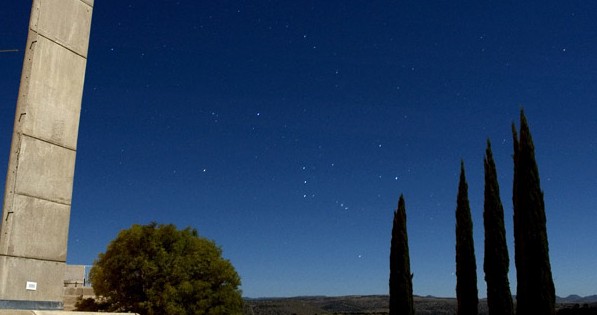
As you gaze up at the night sky, Betelgeuse is the bright star marking Orion the Hunter’s right shoulder. You can see Betelgeuse (pronounced BEEtle jewz) any night Orion is out. Betelgeuse is big. If it were in our solar system in the position of our sun, it would swallow up the earth, and stretch out to Mars and beyond. It’s shrinking. Still, its radius is 500 times that of the sun’s, let’s say. (Figures on Betelgeuse vary, even from stellar sources. It’s a funny-shaped star, and there’s a lot to learn.)
Betelgeuse is getting ready to explode, and it will explode—become a supernova—any minute. Any minute, that is, in the next million years. It could explode as I am writing these words, or it could explode as you are reading them. Or it could explode during our grandchildren’s time, or our great-grandchildren’s. When the explosion does happen, it will be spectacular: as bright as our full moon and easily visible during the day. For several weeks it will delight and amaze us all.
Let me say that when Betelgeuse blows, it will hurt none of us and none of ours, not even a little bit. This is in direct contradiction to many statements awash in that Betelgeuse-sized bin of hogwash known as the Internet. Betelgeuse is too far away (about 640 light years away) to do us harm. That means, of course, that on the day it dazzles the earth it will have blown up 640 years ago. (In August, the supernova PTF 11kly, located in the Pinwheel Galaxy just off the tail of the Big Dipper, came into telescopic view and delighted and amazed at least a few people. That one is 21 million light years away.)
Betelgeuse is big, but it’s not burning. In fact, no stars are burning. Our sun is not burning despite its being our big bonfire in the sky. Ours is a main-sequence star, and it shines (emits energy as light) by fusing hydrogen into helium at its core.
Now pardon my chemistry, but here’s how it works. Nuclear fusion happens when light elements fuse and become heavier elements. An element—like oxygen or hydrogen or iron or carbon—is your basic non-reducible substance. Each element’s atoms have a specific number of positively charged protons at their center (and the same number of negatively charted electrons circling around). Hydrogen is a light element: the hydrogen atom has one proton at its center. Iron is a heavy element, with 26 protons at its center.
No way under ordinary circumstances can one element become another element, because the positively charged protons at the center of atoms repel each other. Only in the center of stars, given huge heat and pressure, can four hydrogen atoms fuse and become one helium atom. The helium atom, with its two protons and two neutrons at its center, has the same number of atomic particles as the four hydrogen atoms (each with one proton), but the mass of this new element, helium, is less than that of the four hydrogen atoms. Thus mass is converted into energy. Thus the sun shines.
The gravity at the center of stars is very great. The reason stars don’t collapse is that the energy released in nuclear fusion pushes outward to counter the force of gravity pushing inward.
Back to Betelgeuse. Betelgeuse has used up its hydrogen. This is why we term it a red giant. Betelgeuse’s helium is now fusing into heavier elements, such as carbon, oxygen, neon, magnesium, sodium, iron. Iron is building up at its core. And iron with its 26 protons is the one element that does not truck in nuclear fusion. It has the lightest mass per nuclear particle; it can’t release energy. All it can do is sit there and grow heavier. Gravity, then, will win. Betelgeuse will collapse and then, in trampoline fashion, explode.
When Betelguese blows, it will spew heavy elements into the universe. From where did we get the iron in our blood, the carbon in our cells, the oxygen in our lungs? From exploding stars, that’s where. We may or may not be starry-eyed, but we are all part star.

